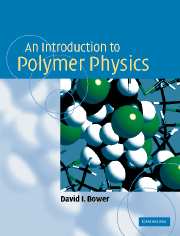Book contents
- Frontmatter
- Contents
- Preface
- Acknowledgements
- 1 Introduction
- 2 Some physical techniques for studying polymers
- 3 Molecular sizes and shapes and ordered structures
- 4 Regular chains and crystallinity
- 5 Morphology and motion
- 6 Mechanical properties I – time-independent elasticity
- 7 Mechanical properties II – linear viscoelasticity
- 8 Yield and fracture of polymers
- 9 Electrical and optical properties
- 10 Oriented polymers I – production and characterisation
- 11 Oriented polymers II – models and properties
- 12 Polymer blends, copolymers and liquid-crystal polymers
- Appendix: Cartesian tensors
- Solutions to problems
- Index
2 - Some physical techniques for studying polymers
Published online by Cambridge University Press: 05 June 2012
- Frontmatter
- Contents
- Preface
- Acknowledgements
- 1 Introduction
- 2 Some physical techniques for studying polymers
- 3 Molecular sizes and shapes and ordered structures
- 4 Regular chains and crystallinity
- 5 Morphology and motion
- 6 Mechanical properties I – time-independent elasticity
- 7 Mechanical properties II – linear viscoelasticity
- 8 Yield and fracture of polymers
- 9 Electrical and optical properties
- 10 Oriented polymers I – production and characterisation
- 11 Oriented polymers II – models and properties
- 12 Polymer blends, copolymers and liquid-crystal polymers
- Appendix: Cartesian tensors
- Solutions to problems
- Index
Summary
Introduction
Many physical techniques are used in the study of solid polymers and some, such as NMR spectroscopy, can give information about a wide variety of features of the structure or properties. On the other hand, some of these features, for instance the degree of crystallinity, can be studied by a wide variety of techniques that give either similar or complementary information. The techniques described in this chapter are those that have a wide applicability within polymer physics or where the description of the technique is most easily introduced by reference to non-polymeric materials. The reader who is already familiar with a particular technique, e.g. X-ray diffraction, may wish to omit the corresponding section of this chapter. It is suggested that other readers should read through the chapter fairly quickly to gain an overall view of the techniques and then look back when applications are referred to in later chapters if they wish to gain a deeper understanding. Techniques that are more specific to polymers are described in the appropriate chapters and only a few, which are generally available only in specialised laboratories, are mentioned without further discussion.
- Type
- Chapter
- Information
- An Introduction to Polymer Physics , pp. 27 - 62Publisher: Cambridge University PressPrint publication year: 2002
- 1
- Cited by



